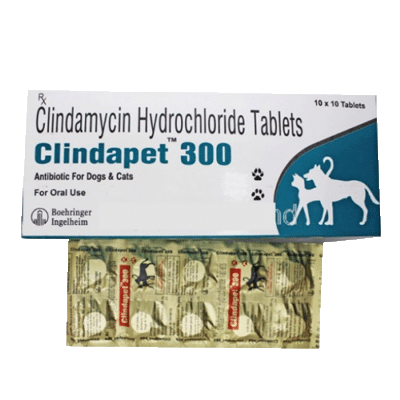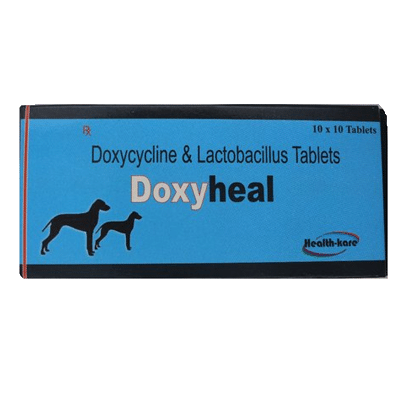The cat started limping, and the doctor said he had a bone infection. They prescribed Clindapet, and after a few days it got noticeably better. I gave it in liquid form, adding it to food, the cat ate without problems. There were no side effects, the only thing was that I had to give it for two weeks, but the main thing is that it helped.

Clindamycin (Clindapet)
Active ingredients: Clindamycin- Quality products
- Support 24/7
- Fast delivery
What is it?
Clindapet is a veterinary drug containing clindamycin, an antibiotic from the lincosamide group. It is indicated for the treatment of bacterial infections in pets, especially dogs and cats. Clindamycin is effective against a variety of gram-positive and some gram-negative bacteria, making it useful in the treatment of skin, soft tissue, bone, and dental infections. The drug is often prescribed for abscesses, wounds, osteomyelitis, and dental disease in animals.
Composition
Clindapet contains the active ingredient clindamycin, which is an antibiotic from the lincosamide group. The drug may also contain excipients that ensure stability and absorption of the drug by the animals body.
- Clindamycin is the main active ingredient with an antibacterial effect.
- Fillers and excipients - help maintain the form and effectiveness of the drug.
- Stabilizers - ensure the safety of the active component.
The drug may be available in different forms: capsules, tablets or liquid solution. This allows you to choose a convenient treatment option depending on the animals condition and the owners preferences.
How to use it?
The use of Clindapet depends on the weight of the animal, the type of infection and the recommendations of the veterinarian. It is very important to strictly follow the instructions to ensure the effectiveness of the treatment and to avoid the development of bacterial resistance.
- Before starting treatment, it is necessary to consult with your veterinarian to determine the exact dosage.
- The drug is usually given orally, in the form of capsules, tablets or liquid, preferably during or after meals to reduce the risk of stomach irritation.
- The dosage is calculated based on the body weight of the animal. Typically, clindamycin is prescribed at a dose of 5 to 10 mg per kilogram of body weight twice a day, but the exact regimen depends on the type of infection.
- The course of treatment is from 7 to 14 days. In cases of severe infections, such as osteomyelitis, therapy may last up to a month.
- Even if symptoms have disappeared, it is necessary to complete the full course of treatment to prevent relapse and the development of bacterial resistance.
- If a dose is missed, do not double the next one. Just continue taking it as usual.
The animal should have constant access to water, as antibiotics can cause increased thirst. If side effects occur during treatment, you should immediately contact your veterinarian.
How does it work?
Clindapet works by using the active ingredient clindamycin, which penetrates into bacterial cells and disrupts their ability to synthesize proteins. This stops the growth and reproduction of pathogens, and in high doses, completely destroys them. Due to this mechanism, the drug is especially effective against infections caused by staphylococci, streptococci and some anaerobic bacteria.
When taken orally, clindamycin is rapidly absorbed into the blood and distributed throughout the bodys tissues. It penetrates well into the skin, bones, teeth and soft tissues, making it useful in the treatment of abscesses, wounds, osteomyelitis and dental infections in animals. The drug is also effective against some parasitic diseases, such as toxoplasmosis, making it a versatile remedy for fighting infections.
Clindapet remains active for several hours after administration, so it is usually given twice a day to maintain a stable concentration in the body. After the course of treatment is completed, the drug is excreted through the liver and kidneys, which makes it safe if the recommended dosages are followed. However, if there are liver or kidney diseases, the dosage may be adjusted by a veterinarian.
Indications
Clindapet is used to treat a variety of bacterial infections in pets. It is particularly effective against skin, soft tissue, bone and oral infections, making it an important tool in veterinary practice. Due to its broad spectrum of action, clindamycin is used to combat a variety of pathogens that are resistant to other antibiotics.
- Bacterial skin infections such as pyoderma, furunculosis and abscesses.
- Soft tissue infections including wounds, bites and post-operative infections.
- Dental infections such as gingivitis, periodontal disease and dental abscesses.
- Osteomyelitis and other bacterial bone infections.
- Respiratory tract infections including bronchitis and pneumonia.
- Treatment of toxoplasmosis in cats.
- Purulent and inflammatory processes in the body caused by bacteria sensitive to clindamycin.
The drug is often prescribed as an independent agent or in combination with other antibiotics to enhance the effect. Before use, it is important to consult a veterinarian to clarify the diagnosis and select the optimal treatment regimen.
Contraindications
Although Clindapet is an effective antibiotic, it cannot be used in all cases. There are certain contraindications in which the use of the drug may harm the animal. Before starting treatment, it is important to make sure that the pet does not have an individual intolerance or other factors that limit the use of clindamycin.
- Allergic reaction or hypersensitivity to clindamycin or lincosamide antibiotics.
- Liver and kidney disease, since the drug is excreted through these organs and can cause additional stress on them.
- Pregnancy and lactation in animals, unless there are clear recommendations from a veterinarian.
- Gastrointestinal disorders, especially associated with inflammatory bowel disease.
- Concomitant use with certain other antibiotics, such as erythromycin, since this may lead to a decrease in the effectiveness of treatment.
- Puppies and kittens under a certain age (usually up to 4 weeks), since their body is not yet able to properly metabolize the drug.
It is important to examine the animal before starting treatment to exclude possible risks. If necessary, your veterinarian can select an alternative antibiotic that will be safer for your pet.
Side Effects
Like any antibiotic, Clindapet can cause side effects, especially with prolonged use or overdose. Although most animals tolerate the drug well, some may experience adverse reactions from various body systems. It is important to monitor your pet during treatment and contact your veterinarian if any alarming symptoms appear.
- Digestive problems such as vomiting, diarrhea, loss of appetite, or increased salivation.
- Allergic reactions including itching, redness of the skin, swelling, or rashes.
- Behavioral changes such as lethargy, apathy, or refusal to eat.
- Liver and kidney problems with long-term use, especially in animals with chronic diseases of these organs.
- Development of bacterial resistance with improper use of the antibiotic, which can lead to a decrease in its effectiveness in the future.
- Rarely, a disruption of the intestinal microflora, causing intestinal inflammation.
If the animal experiences severe side effects, it is necessary to stop taking the drug and consult a veterinarian. In some cases, it may be necessary to reduce the dosage or replace the antibiotic with a more suitable analogue.
Frequently asked questions
Clindapet Reviews and Experiences
The dog had a severe gum infection, and bad breath had already appeared. The vet prescribed Clindapet, and literally a few days later the condition improved. We gave it in capsules, and the dog swallowed them without any difficulties. We did not notice any side effects, the stool was normal, and the appetite was good. Now I will know that this antibiotic helps well with dental problems in animals.
Prescribed to the cat after surgery to prevent infection. The medicine worked great, the wound healed quickly, without complications. The only thing is that the cat did not really want to drink it, had to mix it with food. The appetite decreased a little in the first days, but then everything returned to normal. The main thing is that we completed the course, and everything healed without problems.

